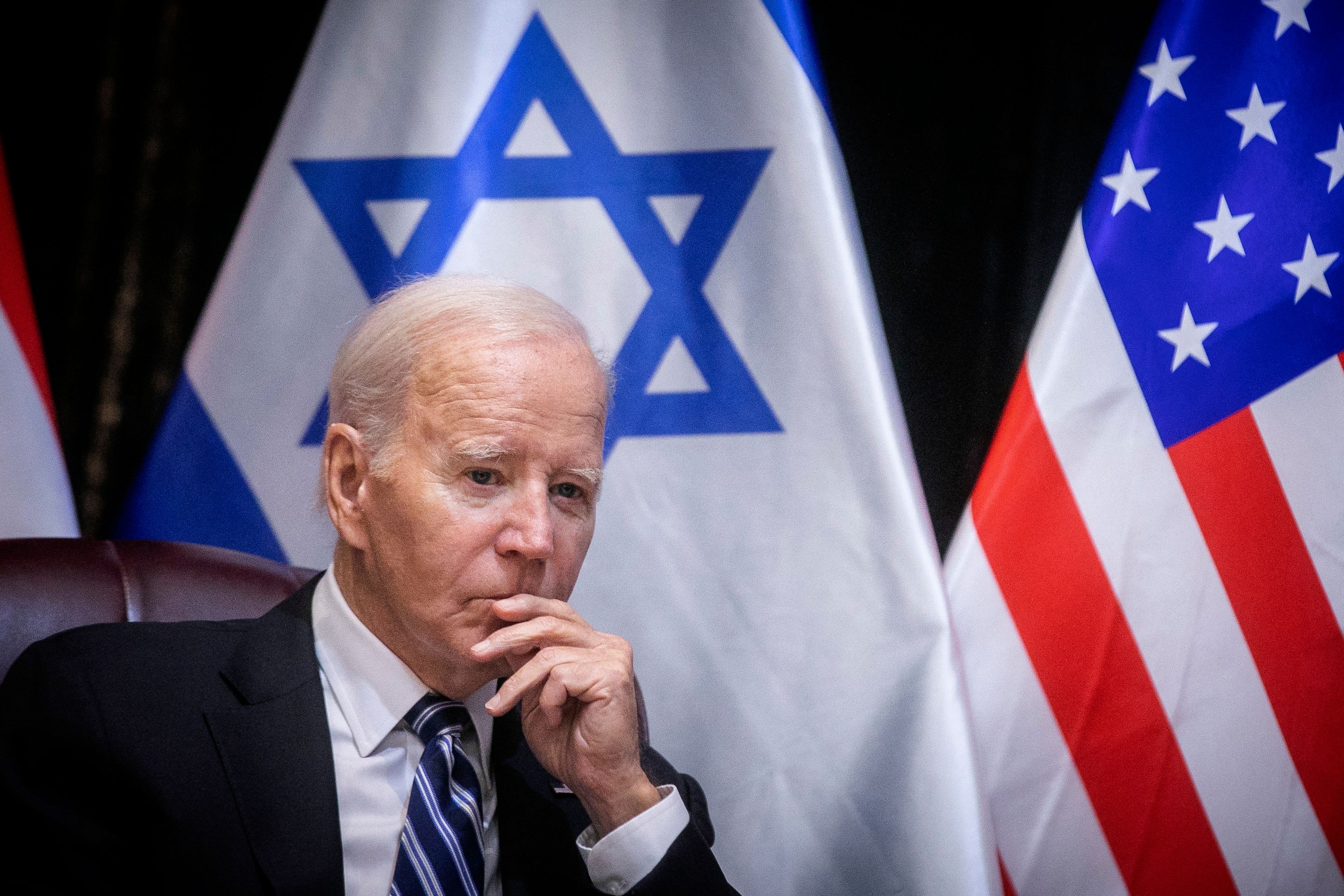
Palestinians displaced by the Israeli ground offensive on the Gaza Strip arrive in the Muwasi area Thursday, Dec. 7, 2023.
Desperation grew Thursday among Palestinians largely cut off from supplies of food and water as Israeli forces engaged in fierce urban battles with Hamas militants. Strikes in the southern Gaza town of Rafah sowed fear in one of the last places where civilians could seek refuge.
United Nations officials say there are no safe places in Gaza nearly a week after Israel widened its offensive into the southern half of the territory. Heavy fighting in and around the city of Khan Younis has displaced tens of thousands of people and cut most of Gaza off from aid deliveries. More than 80% of the territory's population has already fled their homes.
Two months into the war, the grinding offensive has triggered renewed international alarm. U.N Secretary-General Antonio Guterres used a rarely exercised power to warn the Security Council of an impending “humanitarian catastrophe,” and Arab and Islamic nations called for a vote Friday on a draft Council resolution demanding a humanitarian cease-fire.
Gutteres explicitly cited Article 99 of the U.N. Charter, which allows the secretary-general to bring to the council's attention any matter that he believes threatens international peace and security. The power has only been used a handful of times in the history of the world body.
Get top local stories in Philly delivered to you every morning. Sign up for NBC Philadelphia's News Headlines newsletter.
The United States, Israel's closest ally, appears likely to block any U.N. effort to halt the fighting. Still, U.S. concern over the devastation was growing. Before the southern offensive, U.S. officials told Israel it must limit civilian deaths and displacement, saying too many Palestinians were killed when it obliterated much of Gaza City and the north.
On Thursday, Secretary of State Antony Blinken said casualties are still too high in a call with Israeli Minister of Strategic Affairs Ron Dermer, a senior State Department official said. Blinken told Dermer that Israel must also do more to allow humanitarian aid into Gaza. The official spoke on condition of anonymity to discuss the private diplomatic discussion.
Speaking at a joint news conference in Washington with visiting British Foreign Secretary David Cameron, Blinken said it remains imperative that Israel put a premium on civilian protection.
"And there does remain a gap between exactly what I said when I was there (last week) between the intent to protect civilians and the actual results that we’re seeing on the ground,” he said.
Israel says it must crush Hamas' military capabilities and remove it from power following the Oct. 7 attack that ignited the war.
In photos and video published Thursday, at least 100 Palestinian men are seen sitting in rows on a street in northern Gaza, stripped down to their underwear with their heads bowed as they are being guarded by Israeli troops. The Al-Araby Al-Jadeed news outlet said its correspondent Diaa Al-Kahlout was among those detained and had been taken to an unknown location.
The images were the first showing such detentions in the Israeli-Hamas war. Israeli military spokesman Daniel Hagari said troops have detained and interrogated hundreds of people in Gaza suspected of militant links.
Humanitarian crisis worsens
In a sign of the growing desperation, thousands of Palestinians crushed together Thursday waiting to receive aid at a U.N. distribution center in the central Gaza city of Deir al-Balah, the crowds growing more frantic as they swelled. Rami Ashour, one those waiting, said he left when it seemed hopeless his turn would come to pick up a ration of flour.
Residents said the chaotic scene has become common in Deir al-Balah, where a trickle of humanitarian aid is met by hordes of hungry and exhausted families sheltering in U.N. schools or with relatives. The World Food Program has warned of a “catastrophic hunger crisis.”
“There are 8,000 people in this shelter, and any vegetables disappear before I see them because people seize everything so fast,” said Mazen Junaid, a father of six from northern Gaza.
Deir al-Balah is trapped between ground fighting in northern Gaza and in Khan Younis to the south, and it has continued to come under bombardment. Another 115 bodies arrived at the town’s Al-Aqsa Martyrs Hospital over the past 24 hours, the international aid group Doctors Without Borders said.
“The hospital is full, the morgue is full,” the group said on X, formerly known as Twitter.
Only a few trucks have managed to reach central Gaza in recent days because fighting has largely prevented aid groups from distributing beyond the area of Rafah, at Gaza's far southern end by the Egypt border, the U.N. said. Meanwhile, entry of aid from Egypt has slowed.
Rafah is part of the rapidly shrinking area where civilians can seek shelter, and tens of thousands of people have flowed into it from Khan Younis and elsewhere.
The town, normally home to around 280,000 people, was already hosting more than 470,000 displaced people. Shelters and homes have overflowed, and many people have been sleeping in tents or in the streets. Across Gaza, 1.87 million people — over 80% of the population of 2.3 million — have been driven from their homes.
Even in Rafah, safety has proven elusive. Several strikes hit late Wednesday and early Thursday, sending a wave of wounded and dead streaming into a nearby hospital.
The Israeli military accused militants of firing rockets from open areas near Rafah. It released footage of a strike Wednesday on what it said were launchers positioned outside the town and a few hundred meters (yards) from a U.N. warehouse.
Israel’s campaign has killed more than 17,100 people in Gaza — 70% of them women and children — and wounded more than 46,000, according to the territory’s Health Ministry, which says many others are trapped under rubble. The ministry does not differentiate between civilian and combatant deaths.
Battles in north and south
Hamas and other militants killed about 1,200 people, mostly civilians, in the Oct. 7 attack that triggered the war and resulted in the taking of some 240 people hostage. An estimated 138 hostages remain in Gaza, mostly soldiers and civilian men, after 105 were freed during a cease-fire in late November.
Troops have pushed into Khan Younis, Gaza’s second-largest city, which Israeli officials have portrayed as Hamas’ center of gravity — something they previously said was in Gaza City and its Shifa Hospital.
In the afternoon, a strike in the center of Khan Younis left a large field of rubble, and survivors said many people were believed buried underneath. Rescuers pulled bloodied women and children from the shells of gutted buildings.
The military said Thursday that it struck dozens of militant targets in Khan Younis, including a tunnel shaft from which fighters had launched an attack.
Heavy fighting was also still underway in the northern refugee camp of Jabaliya, even after two months of bombardment and encirclement by ground troops. The Israeli military said troops raided a militant compound, killing a number of fighters and uncovering a network of tunnels.
The military reported “close-quarter combat” in the nearby district of Shujaiya, including militants found in a tunnel under a school. The reports could not be independently confirmed.
In the evening, a seven-story building in Gaza City's Rimal district was leveled with dozens of people inside, but with medical services collapsed in the north, no ambulances arrived, a neighbor said.
Israel blames the high civilian death toll on Hamas, accusing it of using them as human shields in residential areas. But Israel has not given detailed accounts of its individual strikes, some of which have destroyed entire city blocks.
Israel says some 5,000 militants have been killed, without saying how it arrived at that count. The military says 87 of its soldiers have been killed in the ground offensive.
An anti-tank missile fired from Lebanon into northern Israel killed an Israeli man, the emergency services said. Hezbollah said its fighters attacked Israeli military posts along the border. Israel responded with intense strikes with helicopters, tanks and artillery, the military said.
Hezbollah and other militants in Lebanon have been exchanging fire nearly daily with Israeli forces over the border. Visiting a northern base Thursday, Netanyahu warned that if Hezbollah escalates to all-out war, Israel’s response will be to “turn Beirut and southern Lebanon … into Gaza and Khan Yunis.”
___
This story has been corrected to show that the Israeli military says 87 of its soldiers have been killed during the Gaza ground offensive, not 88.
___
Chehayeb reported from Beirut and Keath from Cairo. Associated Press correspondents Najib Jobain in Rafah, Gaza Strip, Matthew Lee in Washington and Edith M. Lederer at the United Nations contributed to this report.
___
Full AP coverage at https://apnews.com/hub/israel-hamas-war.



